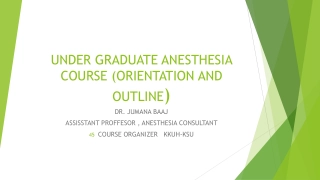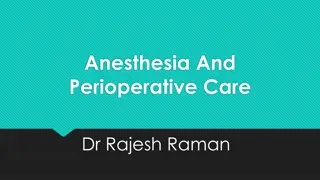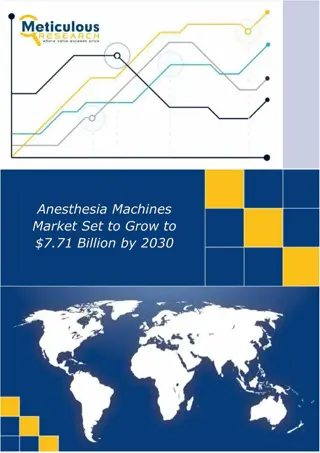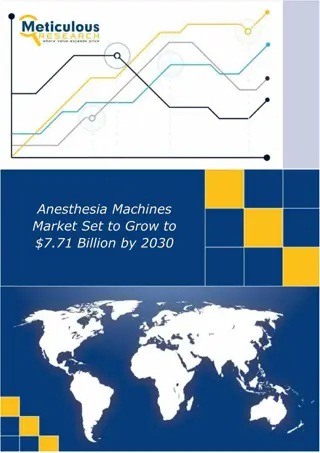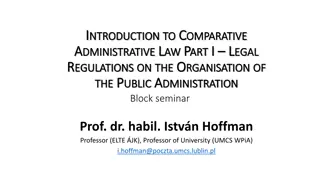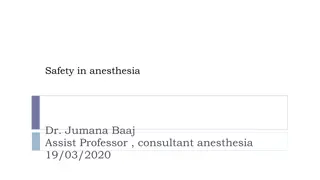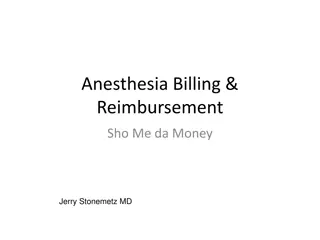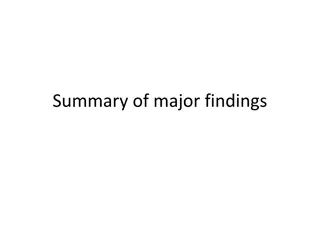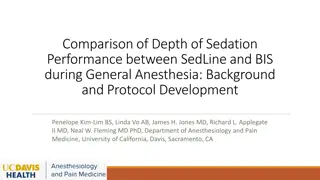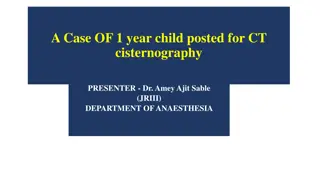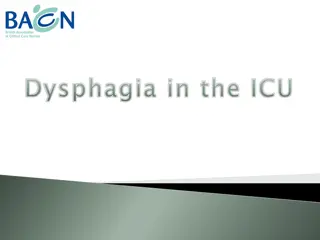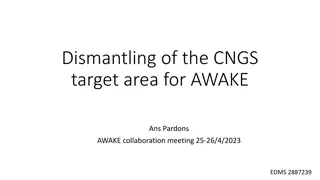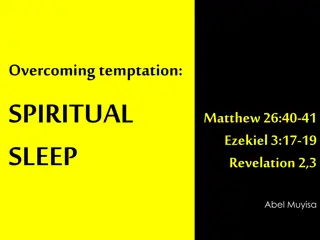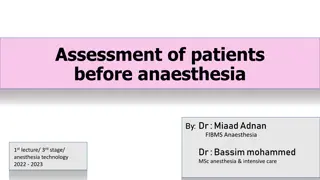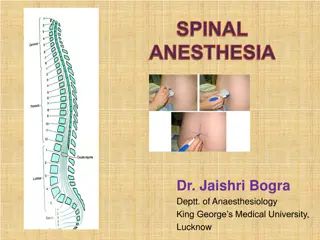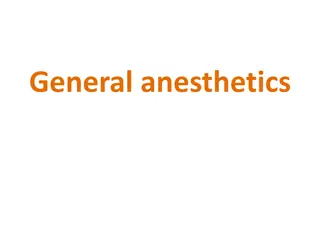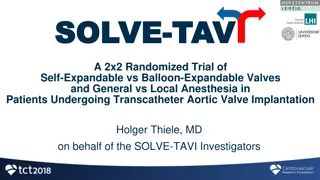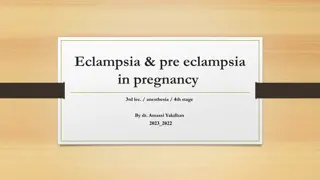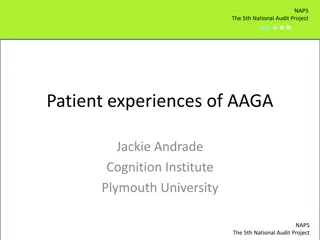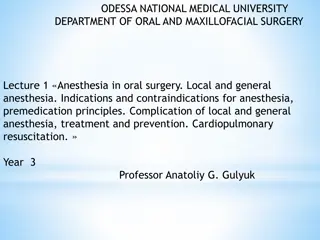Awake vs. Deep Extubation: An Anesthesia Comparison
Explore the differences between awake and deep extubation techniques in anesthesia practice, including learning objectives, stages of anesthesia, safe execution, risks, benefits, appropriate candidates, and management of airway complications. Understand the criteria for awake extubation and indications for deep extubation, along with pearls for safe extubation practices.
Download Presentation

Please find below an Image/Link to download the presentation.
The content on the website is provided AS IS for your information and personal use only. It may not be sold, licensed, or shared on other websites without obtaining consent from the author.If you encounter any issues during the download, it is possible that the publisher has removed the file from their server.
You are allowed to download the files provided on this website for personal or commercial use, subject to the condition that they are used lawfully. All files are the property of their respective owners.
The content on the website is provided AS IS for your information and personal use only. It may not be sold, licensed, or shared on other websites without obtaining consent from the author.
E N D
Presentation Transcript
Awake vs Deep Extubation Dr. Barbara Vickers, MD The Johns Hopkins University Department of Anesthesiology and Critical Care Medicine
Learning Objectives: What is deep extubation? Stages of Anesthesia? How to execute deep extubation safely Risks and benefits of deep extubation Appropriate candidates for deep extubation Managing airway complications
Disclosures No relevant financial relationships
Deep vs Awake Extubation Awakeextubation: Remove LMA or ETT when the patient is awake with airway reflexes intact vs Deepextubation: Removal of LMA or ETT when the patient is still anesthetized and before airway tone and reflexes return
Stages of Anesthesia Stage 1: Disorientation - induction, ends with loss of consciousness Stage 2: Excitement or disinhibition Stage 3: Surgical Anesthesia - Safe for intubation and surgery Stage 4: Overdose and possible cardiovascular compromise
Pearls of Safe Extubation Avoid extubating during Stage 2: Disconjugate gaze Irregular respiratory pattern or breath holding Injected conjunctiva Increased salivation Increased heart rate Localizing to noxious stimulation but not awake enough to follow commands Stage 2 is associated with airway irritability.Intubating or extubating during Stage 2 can lead to laryngospasm This slide
Criteria for Awake Extubation Swallowing/coughing indicate return of airway reflexes Eye opening Eyes are conjugate Reaching for ETT Head lift for at least 10 seconds Regular respiratory pattern with adequate tidal volumes Following commands (observed in older kids and adults)
Indications for Deep Extubation There are no absolute indications for deep extubation Consider deep extubation for: - Intracranial surgery - Middle ear surgery - Thyroidectomy - Open globe surgery
Contraindications for Deep Extubation Difficult mask ventilation or difficult intubation Nose/airway surgery with residual bleeding/secretions present Patients with full stomach Patients with GERD Patients with intestinal obstruction Morbid obesity Lung disease prone to CO2 retention Pulmonary hypertension
Benefits of Deep Extubation Less coughing/bucking in ETT and smoother emergence Ideal when there is risk of increased intra- ocular pressure, wound dehiscence or bleeding at surgical site Decreased bronchospasm in asthmatic patients Increased OR efficiency
Successful Deep Extubation Increase FiO2 Reversal of NMB Return of spontaneous ventilation Titrate narcotics to respiratory rate Optimize depth of anesthetic by increasing volatile to full MAC IV lidocaine to blunt airway reflexes
Successful Deep Extubation Gently suction airway prior to extubation Consider turning patient to lateral position to minimize secretions pooling in posterior oral pharynx and tongue falls forward, rather than backwards Consider placing oral airway prior to extubation If patient reacts during the above maneuvers, deepen with sevoflurane, Propofol and/or narcotics before extubating
Successful Deep Extubation Remove ETT and confirm patent airway Give positive-pressure breath if needed If not able to ventilate via facemask, utilize an oral airway and or jaw thrust for upper airway obstruction Transport to PACU with pulse oximetry monitoring if available and oxygen delivery with Jackson Reese circuit and facemask
Risks of Deep Extubation Upper airway obstruction from decreased airway tone Laryngospasm after extubation Aspiration of secretions or gastric contents
Recognizing Upper Airway Obstruction after Deep Extubation Inadequate air movement with facemask application on ETCO2 monitor or by auscultation with stethoscope Desaturation Tugging or See-Saw chest movement
Treating Upper Airway Obstruction after Deep Extubation Ensure adequate seal with facemask Oral airway Jaw thrust, two handed face mask Lateral position Positive pressure ventilation until airway tone improves as level of anesthesia decreases
Incidence of Laryngospasm Reported 1% overall in adults and children1 Greater incidence in children and infants than adults Highest incidence (10%) in children with reactive airway disease, asthma or upper respiratory tract infection1 1 G.Gavel; Laryngospasm in Anesthesia. British Journal of Anesthesia, April 2014, 14(2); Pages 47 51
Morbidity of Laryngospasm Australian Incident Monitoring Study3 Significant hypoxemia in 61% Bradycardia in 6% of adults and children Bradycardia in 23% of children < 1 year old Post-obstructive pulmonary edema in 4% Pulmonary aspiration in 3% 3 Webb RK; The Australian Incident Monitoring Study: an analysis of 2000 incident reports. Anaesth Intensive Care. 1993 Oct;21(5):520-8. doi: 10.1177/0310057X9302100507. PMID: 8273871
LMA vs ETT: Which has less complications following deep extubation4 Meta-analysis of 17 trials4 1881 patients No significant difference in incidence of complications following deep extubation with LMA vs ETT This study found the incidence of laryngospasm to be 3.7% overall. 4Chang-Hoon Koo. Deep vs. Awake Extubation and LMA Removal in Terms of Airway Complications in Pediatric Patients Undergoing Anesthesia: A Systemic Review and Meta-Analysis. Journal of Clinical Medicine, 2018 Oct; 7(10): 353
Management of Laryngospasm Call for help Positive pressure ventilation (PPV) with two handed facemask with jaw thrust and high peak inspiratory pressure (may need up to 50 cm H2O) If unable to break laryngospasm with PPV administer 1-2 mg/kg of Propofol (1-2 mg/kg) If unable to break laryngospasm with Propofol administer succinylcholine 0.1 mg/kg IV or Rocuronium (0.3-0.5 mg/kg)
Conclusions: Deep extubations can be helpful when performed by an airway expert Always prepare for the worst: Have a plan in place for rescuing a patient with airway obstruction following extubation
References: 1. Guedel,A. Anesthesia: A teaching outline. Stages of Anesthesia. Anesthesia and Analgesia, 1936 Stoelting,R., R.Miller; Basics of Anesthesia; 5th ed. 2007 Chapter 16. 2. P.Davis; Smith s Anesthesia for Infants and Children; 9th ed. Chapter 16: Respiratory Disorders 3. 4. M. Ramez Salem; Understanding the Mechanics of Laryngospasm Is Crucial for Proper Treatment, editorial. Anesthesiology, August 2012: Vol.117, 441-442 5. Fink BR; The etiology and treatment of laryngeal spasm. Anesthesiology, 1956; 17:569 77 6. G.Gavel; Laryngospasm in Anesthesia. British Journal of Anesthesia, Volume 14, Issue 2, April 2014, Pages 47 51 7. Webb RK; The Australian Incident Monitoring Study: an analysis of 2000 incident reports. Anaesth Intensive Care. 1993 Oct;21(5):520-8. doi: 10.1177/0310057X9302100507. PMID: 8273871 8. Visvanathan, T., Kluger MT, Webb RK, Westhorpe RN Crisis management during anaesthesia: laryngospasm, Qual Saf Health Care , 2005, vol. 14 pg. e3 9. Chang-Hoon Koo. Deep vs. Awake Extubation and LMA Removal in Terms of Airway Complications in Pediatric Patients Undergoing Anesthesia: A Systemic Review and Meta-Analysis. Journal of Clinical Medicine, 2018 Oct; 7(10): 353


